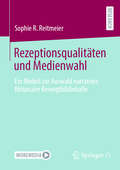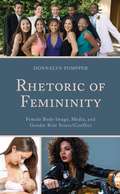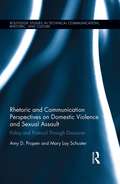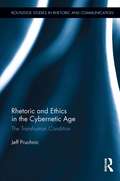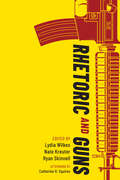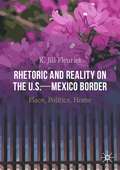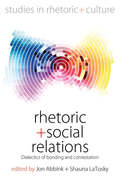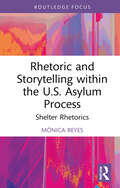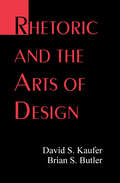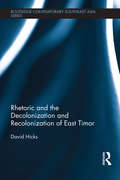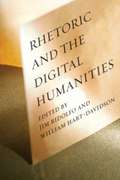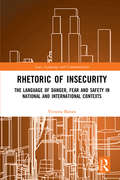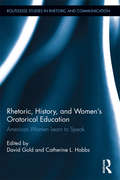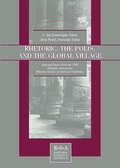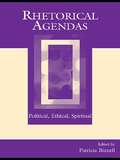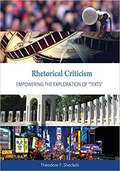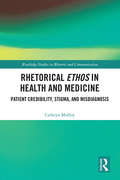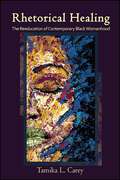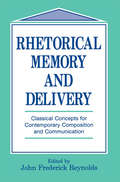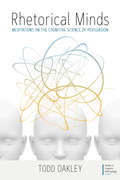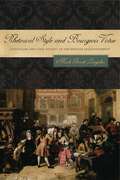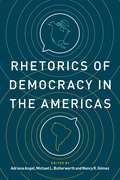- Table View
- List View
Rezballers and Skate Elders: Joyful Futures in Indian Country
by David KamperEthnographer and American Indian studies scholar David Kamper examines how Indigenous youth and adults are making basketball and skateboarding meaningful to their communities by sustaining the transmission of intergenerational knowledge and combatting intergenerational trauma. Kamper looks at how the events and tournaments built around rezball are similar to powwows in how they bring people together across localized communities and generations and he coins the phrase &“skate elders&” for those who use the social nature of skateboarding to build community and mentorships. Through a broad picture of North America, Kamper demonstrates how Native peoples have long indigenized cultural practices and material culture to assert Native sovereignty, creating joy and hope in the process. In Rezballers and Skate Elders Kamper considers how Native expressions of basketball and skateboarding show continuities with the historical transformation of practices that originated outside Indian Country to make them meaningful in Native life.
Rezeptionsprozesse im Umgang mit den Leer- und Unbestimmtheitsstellen eines visuell erzählenden Bilderbuchs: Eine qualitativ-empirische Studie mit Leseanfänger*innen
by Katharina RistRezeptionsprozesse im Umgang mit literarischer Unbestimmtheit gehören zu den zentralen Anforderungen des Literaturunterrichts und können bereits von Beginn der Primarstufe an herausgefordert und unterstützt werden. Die Entwicklung entsprechender didaktischer Modelle setzt empirische Befunde zum Umgang von Leseanfänger*innen mit den Leer- und Unbestimmtheitsstellen literarischer Werken voraus, wie sie die vorliegende qualitativ-empirische Studie liefert. Das theoretische Fundament bildet dabei die eigenständige Entwicklung einer an Konzepten aus der Literaturwissenschaft sowie der Kunst- und Medienforschung orientierten Systematik der Leer- und Unbestimmtheitsstellen visuell erzählender Bilderbücher. Darüber hinaus liegt der Studie eine gründliche Sichtung innerhalb unterschiedlicher Fachdisziplinen vorliegender theoretischer Annahmen zu den durch Leer- und Unbestimmtheitsstellen evozierten Rezeptionsprozessen zugrunde. Die Untersuchung von Rezeptionsgesprächen zu einem visuell erzählenden Bilderbuch im Rahmen der Studie macht nicht zuletzt das hohe Potenzial des visuell erzählenden Bilderbuchs als Rezeptionsgegenstand sowie des Umgangs mit literarischer Unbestimmtheit als zentralen Schritt der Rezeption für das literarische Lernen im Lese- und Literaturunterricht deutlich. Damit liefert sie einen wichtigen Beitrag zur empirischen Grundlagenforschung in der Literaturdidaktik.
Rezeptionsqualitäten und Medienwahl: Ein Modell zur Auswahl narrativer, fiktionaler Bewegtbildinhalte
by Sophie R. ReitmeierSophie Reitmeier widmet sich in ihrem Buch der Frage, wie wir uns für eine Serie oder einen Film entscheiden. In Anlehnung an bereits vorliegende Konzepte teilt sie (Selektions-)Entscheidungen in zwei Phasen ein. In der sogenannten Editing-Phase findet zunächst eine Eingrenzung auf eine überschaubare Auswahl an Optionen statt. In einer darauffolgenden Bewertungsphase werden diese Optionen bewertet und auf Basis dieser Bewertung wird eine Entscheidung getroffen. Die Autorin setzt sich mit der Editing-Phase lediglich theoretisch und konzeptionell auseinander. Die Bewertungsphase wird in einem Forschungsmodell spezifiziert und mittels Befragung empirisch überprüft. Die Ergebnisse der Korrelationsstudie zeigen, dass Rezipient*innen ausgehend von ihrer situativen Einstellung (dem erwarteten Gewinn) eine Verhaltensintention (Präferenz für eine Option) entwickeln und ausgehend davon eine Entscheidung treffen. Das Wissen über die zur Verfügung stehenden Optionen spielt eine tragende Rolle und mit steigendem Wissen steigt auch die Präferenz für den jeweiligen Inhalt.
Rhetoric Of Femininity: Female Body Image, Media, and Gender Role Stress/Conflict (Lexington Studies In Contemporary Rhetoric)
by Donnalyn PompperTo explore the question, What is femininity?, the study reported in this book enjoins diverse women's definitions with a critique of ways girls and women are represented across media and popular culture and the stress/conflict they experience as a result.
Rhetoric and Communication Perspectives on Domestic Violence and Sexual Assault: Policy and Protocol Through Discourse (Routledge Studies in Technical Communication, Rhetoric, and Culture)
by Amy D. Propen Mary SchusterThis book brings rhetorical, legal, and professional communication perspectives to the discourse surrounding policy-making efforts within the United States around two types of violent crimes against women: domestic violence and sexual assault. The authors propose that such analysis adds to our understanding of rhetorical concepts such as kairos, risk perception, moral panic, genre analysis, and identity theory. Overall, the goal is to demonstrate how rhetorical, legal, and professional communication perspectives work together to illuminate public discourse and conflict in such complicated and ongoing dilemmas as how to aid victims of domestic violence and sexual assault, and how to manage the offenders of such crimes—social and cultural problems that continue to perplex the legal system and the social environment.
Rhetoric and Ethics in the Cybernetic Age: The Transhuman Condition (Routledge Studies in Rhetoric and Communication #17)
by Jeff PruchnicIt has become increasingly difficult to ignore the ways that the centrality of new media and technologies — from the global networking of information systems and social media to new possibilities for altering human genetics — seem to make obsolete our traditional ways of thinking about ethics and persuasive communication inherited from earlier humanist paradigms. This book argues that rather than devoting our critical energies towards critiquing humanist touchstones, we should instead examine the ways in which media and technologies have always worked as crucial cultural forces in shaping ethics and rhetoric. Pruchnic combines this historical itinerary with critical interrogations of diverse cultural and technological sites — the logic of video games and artificial intelligence, the ethics of life extension in contemporary medicine, the transition to computer-automated trading in world stock markets, the state of critical theory in the contemporary humanities — along with innovative analyses of the works of such figures as the Greek Sophists, Kenneth Burke, Martin Heidegger, Michel Foucault, Friedrich Nietzsche, and Gilles Deleuze. This book argues that our best strategies for crafting persuasive communication and producing ethical relations between individuals will be those that creatively replicate and appropriate, rather than resist, the logics of dominant forms of media and technology.
Rhetoric and Guns
by Ryan Skinnell Lydia Wilkes Nate KreuterGuns hold a complex place in American culture. Over 30,000 Americans die each year from gun violence, and guns are intimately connected to issues of public health, as is evident whenever a mass shooting occurs. But guns also play an important role in many Americans’ lives that is not reducible to violence and death—as tools, sporting equipment, and identity markers. They are also central to debates about constitutional rights, as seen in ongoing discussions about the Second Amendment, and they are a continuous source of legislative concern, as apparent in annual ratings of gun-supporting legislators. Even as guns are wrapped up with other crucial areas of concern, they are also fundamentally a rhetorical concern. Guns and gun violence occupy a unique rhetorical space in the United States, one characterized by silent majorities, like most gun owners; vocal minorities, like the firearm industry and gun lobby; and a stalemate that fails to stem the flood of the dead. How Americans talk, deliberate, and fight about guns is vital to how guns are marketed, used, and regulated. A better understanding of the rhetorics of guns and gun violence can help Americans make better arguments about them in the world. However, where guns are concerned, rhetorical studies is not terribly different from American culture more generally. Guns are ever-present and exercise powerful effects, but they are commonly talked about in oblique, unsystematic ways. Rhetoric and Guns advances more direct, systematic engagement in the field and beyond by analyzing rhetoric about guns, guns in rhetoric, and guns as rhetoric, particularly as they relate to specific instances of guns in culture. The authors attempt to understand rhetoric’s relationship to guns by analyzing rhetoric about guns and how they function in and as rhetoric related to specific instances—in media coverage, political speech, marketing, and advertising. Original chapters from scholars in rhetorical studies, communication, education, and related fields elucidate how rhetoric is used to maintain and challenge the deadly status quo of gun violence in the United States and extend rhetoricians’ sustained interest in the fields’ relationships to violence, brutality, and atrocity. Contributors: Ira J. Allen, Brian Ballentine, Matthew Boedy, Peter Buck, Lisa Corrigan, Rosa Eberly, Kendall Gerdes, Ian E. J. Hill, Nathalie Kuriowa-Lewis, Patricia Roberts-Miller, Craig Rood, Bradley Serber, Catherine R. Squires, Scott Gage
Rhetoric and Reality on the U.S.—Mexico Border: Place, Politics, Home
by K. Jill FleurietStemming from four years of ethnographic research, media analysis of over 750 national news articles published in the 2010s, and decades of the author’s professional and personal immersion in the Rio Grande Valley of south Texas, Rhetoric and Reality illuminates a place at the heart of our national conversation: the U.S.-Mexico border. K. Jill Fleuriet contrasts the rhetoric of national political and media discourse with that of local border leaders in economics, health care, politics, education, law enforcement, philanthropy, and activism. As she deconstructs the common narrative of a border in need of external intervention to control corruption, poverty, sickness, and violence, Fleuriet engagingly illustrates the range of regional organizing, local development strategies, and community responses in the borderlands that ultimately situate the Rio Grande Valley as the “true North” of the U.S. national compass—where the Valley goes, the rest of the country soon will follow. Rhetoric and Reality asks us to question our own assumptions, especially about those areas that drive national decisions about resource allocation, economic development and national security.“Rhetoric and Reality is an important ethnographic study of the deeply misunderstood, increasingly vilified, Rio Grande Valley located on the Texas-Mexico border. Fleuriet presents a balanced counter-narrative that that shows the region as one of growth, innovation, complexity, and rich with meaning. Rhetoric and Reality is an excellent example of place-based, reflexive scholarship appropriate for use in courses on border theory, applied anthropology, and research methods. Written clearly and crisply with a wide readership in mind, Rhetoric and Reality is mandatory reading for those wanting to better understand the US-Mexico border region and the people who live there.”--Margaret A. Graham, Professor and Chair, The University of Texas Rio Grande Valley, USA“This is an important book, as it describes life in the Rio Grande Valley rather than ‘on the border.’ The notion of ‘the border’ as an open range in need of external help is challenged, as the author illustrates the wide range of leadership and programmatic change occurring in the Rio Grande Valley.”--Roberto R. Alvarez, Professor Emeritus of Ethnic Studies, University of California, San Diego, USA
Rhetoric and Social Relations: Dialectics of Bonding and Contestation (Studies in Rhetoric and Culture #8)
by Jon Abbink Shauna LaToskyThis volume explores the constitutive role of rhetoric in socio-cultural relations, where discursive persuasion is so important, and contains both theoretical chapters as well as fascinating examples of the ambiguities and effects of rhetoric used (un)consciously in social praxis. The elements of power, competition and political persuasion figure prominently. It is an accessible collection of studies, speaking to common issues and problems in social life, and shows the heuristic and often explanatory value of the rhetorical perspective.
Rhetoric and Storytelling within the U.S. Asylum Process: Shelter Rhetorics (Routledge Studies in Rhetoric and Communication)
by Mónica ReyesThis book explores the U.S. asylum process and how those seeking shelter deal with the rhetorical pressures of compelling asylum narratives they need to write in order to stay.Centered around a study conducted at a shelter on the U.S. border, this book moves beyond this context to demonstrate how liminal sites provide opportunities for displaced communities to employ distinct shared rhetorical practices of daily life—like silence and routine—that both safeguard vulnerabilities and enact agency for individuals within precarious spaces. Placing people who seek asylum and those who work with them as rhetorical and socio-cultural experts on this issue, the study adds to the emerging importance of rhetoric within discussions of asylum and forced migration and demonstrates the significance of rhetorical ecology theory as part of a blended methodology in understanding people seeking asylum as a group in a perpetual and explicit state of ethos development.Highlighting the need for support which is sensitive to the narrative struggles people seeking asylum face, this book will have important findings for scholars and upper-level students of cultural rhetorics, feminist rhetoric, migration studies, political science, and intercultural communication.
Rhetoric and the Arts of Design
by David S. Kaufer Brian S. ButlerThe design arts -- from the design of buildings and machines to software and interfaces -- are associated with types of knowledge and performance thought to be structured, modular, and systematic. Such arts have become increasingly prestigious in our technocratic society. Since Aristotle, the art of rhetoric was conceived as a loosely structured "practical" art thought to be limited in the extent to which it could mimic more precise subject matters. The art of rhetoric has been controversial since classical times, but its status has sunk even lower since the industrial revolution -- a point when civic cultures began to cede authority and control to the cultures of specialized experts. Many sympathizers of rhetoric have resisted its decline by calling for a civic art of public discourse to stand in opposition to a technocratic specialized discourse that has come, increasingly, to disenfranchise the ordinary citizen. This is the first book to question the rhetoric/technical knowledge split from a more fundamental perspective. To get some perspective on what is at stake in rhetoric's traditional classification as a "practical" art, the authors: * explore the distinction between practical and design arts; * enumerate the various criteria cited in the literature for qualifying a cluster of knowledge and performative skills to count as an art of design; * show how the knowledge and performative skills associated with the art of rhetoric meet the major requirements of design knowledge; * propose a general architecture of rhetorical design, one descriptive both of civic address and specialized academic argument; * turn to the Lincoln/Douglas debates to embody and provide some empirical support and illustration for their architecture; * demonstrate how Lincoln and Douglas can be thought of as expert designers whose rhetoric is highly structured and modular; and * explain how the rhetoric of both rhetorical agents can be represented in the layers and modules that one needs to display plans for buildings, software, or other design artifacts. These layers and modules are not just post hoc annotations of the debates; they also illuminate new and systematic ways for viewing the debates -- and by implication, other specimens of rhetoric -- in terms of strategies of artistic production. Kaufer and Butler conclude their presentation by citing some of the research and educational implications that follow from housing rhetoric within the family of design arts.
Rhetoric and the Decolonization and Recolonization of East Timor (Routledge Contemporary Southeast Asia Series)
by David HicksBy the end of the 1960s the process of decolonization had practically run its course in Southeast Asia. One exception, however, was tiny Portuguese Timor, where notions of self-determination and independence had yet to be generated. In 1974, the Carnation Revolution in Portugal brought about the end of fifty years of dictatorship, and halfway around the world, presented a new opportunity to a small, ambitious proportion of the Timorese population, eager to shape the future of their country. This book presents a compelling and original perspective on the critical period of 1974-1975 in the history of East Timor. It describes how the language of politics helped to shape the events that brought about the decolonization of Portuguese Timor, its brief independence as The Democratic Republic of East Timor, and its recolonization by an Asian neighbour. Further, it challenges the idea that this period of history was infused by the spirit of nationalism in which the majority Timorese partook, and which contended with other competing western –isms, including colonialism, communism, neo-colonialism, and fascism. In contrast, the book argues that the Timorese majority had little understanding of any of these alien political abstractions and that the period can be most effectively explained and understood in terms of the contrast between the political culture of Dili, the capital, and the political culture of the rest of the country. In turn, David Hicks highlights how the period of 1974-1975 can offer lessons to government and international policy-makers alike who are trying to bring about a transformation in governance from the traditional to the legal and convert individuals from peasants to citizens. The result of extensive fieldwork and interviews, this book will be of interest to students and scholars of Southeast Asian studies, international relations, post-conflict studies and post-colonial studies.
Rhetoric and the Digital Humanities
by Jim Ridolfo and William Hart-DavidsonThe digital humanities is a rapidly growing field that is transforming humanities research through digital tools and resources. Researchers can now quickly trace every one of Issac Newton’s annotations, use social media to engage academic and public audiences in the interpretation of cultural texts, and visualize travel via ox cart in third-century Rome or camel caravan in ancient Egypt. Rhetorical scholars are leading the revolution by fully utilizing the digital toolbox, finding themselves at the nexus of digital innovation.Rhetoric and the Digital Humanities is a timely, multidisciplinary collection that is the first to bridge scholarship in rhetorical studies and the digital humanities. It offers much-needed guidance on how the theories and methodologies of rhetorical studies can enhance all work in digital humanities, and vice versa. Twenty-three essays over three sections delve into connections, research methodology, and future directions in this field. Jim Ridolfo and William Hart-Davidson have assembled a broad group of more than thirty accomplished scholars. Read together, these essays represent the cutting edge of research, offering guidance that will energize and inspire future collaborations.
Rhetoric of InSecurity: The Language of Danger, Fear and Safety in National and International Contexts (Law, Language and Communication)
by Victoria BainesThis book demands that we question what we are told about security, using tools we have had for thousands of years. The work considers the history of security rhetoric in a number of distinct but related contexts, including the United States’ security strategy, the "war" on Big Tech, and current concerns such as cybersecurity. Focusing on the language of security discourse, it draws common threads from the ancient world to the present day and the near future. The book grounds recent comparisons of Donald Trump to the Emperor Nero in a linguistic evidence base. It examines the potential impact on society of policy-makers’ emphasis on the novelty of cybercrime, their likening of the internet to the Wild West, and their claims that criminals have "gone dark". It questions governments’ descriptions of technology companies in words normally reserved for terrorists, and asks who might benefit. Interdisciplinary in approach, the book builds on existing literature in the Humanities and Social Sciences, most notably studies on rhetoric in Greco-Roman texts, and on the articulation of security concerns in law, international relations, and public policy contexts. It adds value to this body of research by offering new points of comparison, and a fresh but tried and tested way of looking at problems that are often presented as unprecedented. It will be essential to legal and policy practitioners, students of Law, Politics, Media, and Classics, and all those interested in employing critical thinking.
Rhetoric, History, and Women's Oratorical Education: American Women Learn to Speak (Routledge Studies in Rhetoric and Communication)
by David Gold Catherine L. HobbsHistorians of rhetoric have long worked to recover women's education in reading and writing, but have only recently begun to explore women's speaking practices, from the parlor to the platform to the varied types of institutions where women learned elocutionary and oratorical skills in preparation for professional and public life. This book fills an important gap in the history of rhetoric and suggests new paths for the way histories may be told in the future, tracing the shifting arc of women's oratorical training as it develops from forms of eighteenth-century rhetoric into institutional and extrainstitutional settings at the end of the nineteenth century and diverges into several distinct streams of community-embodied theory and practice in the twentieth. Treating key rhetors, genres, settings, and movements from the early republic to the present, these essays collectively challenge and complicate many previous claims made about the stability and development of gendered public and private spheres, the decline of oratorical culture and the limits of women's oratorical forms such as elocution and parlor rhetorics, and women's responses to rhetorical constraints on their public speaking. Enriching our understanding of women's oratorical education and practice, this cutting-edge work makes an important contribution to scholarship in rhetoric and communication.
Rhetoric, the Polis, and the Global Village: Selected Papers From the 1998 Thirtieth Anniversary Rhetoric Society of America Conference
by David S. Kaufer C. Jan SwearingenRhetoric, the Polis, and the Global Village represents current thought on the role of rhetoric in various disciplines, and includes such diverse topics as race, technology, and religion, demonstrating the expanding relevance of rhetoric in today's world. The essays included in this volume address the question of the polis in ancient and modern times, gradually converging with the more recent 30-year span between the decade of the Global Village and today's rhetorical rehearsals for a political global economy. Originating from the 1998 Rhetoric Society of America's biennial conference, and representing the 30-year anniversary of the organization, this volume offers to all readers the keynote lectures and selected papers celebrating the universality of rhetoric across cultures. As a benchmark for the scholarship and growth of the rhetoric discipline in recent history, it will be of great interest to scholars in classical and contemporary rhetoric, writing, and other fields in which rhetoric has attained critical significance and influence.
Rhetorical Agendas: Political, Ethical, Spiritual
by Patricia BizzellThis edited collection offers a broad consideration of contemporary rhetorical scholarship, tied to political, ethical, and spiritual themes. Originating from the 2004 conference of the Rhetoric Society of America, the contents of this volume reflects the conference themes of rhetorical agendas in current theory and research. The volume starts off with transcripts of the talks presented by the conference's featured speakers. The essays that follow are organized around five key topics: history, theory, pedagogy, publics, and gender. These chapters address subjects ranging from religious identity to civil rights; from weapons of mass destruction to literacy testing and electronic texts, reflecting the wide array of areas under study across the rhetoric discipline. With contributions from well-known scholars as well as newcomers, the breadth and diversity of this collection make a significant contribution to rhetorical scholarship, and will stimulate additional work. As such, the volume will be of interest to scholars and students in rhetoric studies in speech communication, English, and related disciplines.
Rhetorical Criticism
by Theodore F. SheckelsRhetorical Criticism: Empowering the Exploration of “Texts” encourages students to analyze texts of various sorts—speeches, advertisements, memory sites, and more—to gain a clear understanding of what the text has to say and how it persuades or otherwise affects its audience. The book clearly and succinctly helps students build the skills required to easily and effectively practice rhetorical criticism. <p><p> The book begins with a chapter that defines “rhetoric,” “criticism,” and “text,” demonstrates how theory-based rhetorical criticism can be exciting, and emphasizes that there are many diverse lenses through which to illuminate texts. The proceeding chapters explore various types of rhetorical criticism, including classical, The Chicago School, Burkean, fantasy theme, narrative, genre, mythological, Bahktinian, ideological, feminist, and constitutive. Each chapter begins by explaining the theory in which the critical approach is based. It then explains how a critic utilizing that particular type of rhetorical criticism manages the critical process and offers the reader an extended example of the critical approach in use. <p><p> Conversational in nature and inclusive of a wide range of critical methods, Rhetorical Criticism is ideal for undergraduate courses in rhetoric-oriented courses. <p><p> Theodore F. Sheckels is the Charles Potts Professor of Social Science as well as professor of English and communication studies at Randolph-Macon College. He earned his Ph.D. and M.A. from Pennsylvania State University. Dr. Sheckels has contributed numerous articles and book chapters to publications within his field and has published six books. His research interests include the political dimensions of Margaret Atwood’s fiction, presidential debates, and lesser-known political communicators from the 20th Century.
Rhetorical Ethos in Health and Medicine: Patient Credibility, Stigma, and Misdiagnosis (Routledge Studies in Rhetoric and Communication)
by Cathryn MolloyThis book explores rhetorical ethos and its ongoing role in patients’ credibility and in misdiagnoses stemming from gender, race and class-based biases. Drawing on the concept of ethos as a theoretical framework, it explores health and mental illness across different conditions and across different methodological approaches. Extending work on ethos in clinical encounters and public discourse about biomedicine and presenting new research on the rhetoric of mental health, stigma and mental illness, the book explores how bias in clinical settings can lead to symptoms labelled "in the patient’s head" masking treatable medical problems. This notable contribution to the rhetoric of health and medicine will be of interest to all researchers and graduate students of rhetoric and composition studies, rhetoric of health and medicine, disability studies, medical humanities, communication, and psychology.
Rhetorical Healing: The Reeducation of Contemporary Black Womanhood (SUNY series in Feminist Criticism and Theory)
by Tamika L. CareySince the Black women's literary renaissance ended nearly three decades ago, a profitable and expansive market of self-help books, inspirational literature, family-friendly plays, and films marketed to Black women has emerged. Through messages of hope and responsibility, the writers of these texts develop templates that tap into legacies of literacy as activism, preaching techniques, and narrative formulas to teach strategies for overcoming personal traumas or dilemmas and resuming one's quality of lifeDrawing upon Black vernacular culture as well as scholarship in rhetorical theory, literacy studies, Black feminism, literary theory, and cultural studies, Tamika L. Carey deftly traces discourses on healing within the writings and teachings of such figures as Oprah Winfrey, Iyanla Vanzant, T. D. Jakes, and Tyler Perry, revealing the arguments and curricula they rely on to engage Black women and guide them to an idealized conception of wellness. As Carey demonstrates, Black women's wellness campaigns indicate how African Americans use rhetorical education to solve social problems within their communities and the complex gender politics that are mass-produced when these efforts are commercialized.
Rhetorical Memory and Delivery: Classical Concepts for Contemporary Composition and Communication (Routledge Communication Series)
by John Frederick ReynoldsWhy has classical rhetoric been a subject of such growing interest for the past ten years? Because the most exciting work in classical rhetoric has asked us to rethink classical concepts in modern terms. What's been missing, at least in book-length form, is a scholarly rethinking of rhetorical memory and delivery. As many scholars have been noting in their work for some time now, three of five classical issues -- invention, arrangement, and style -- have dominated rhetorical studies while the other two -- memory and delivery -- have largely been misunderstood or ignored. Re-examined in light of recent research on orality, literacy, and electronic technology, rhetorical memory and delivery issues can become not only central to the field but also key to the continued interest in classical rhetoric. Bringing together national scholars from a variety of related disciplines in which rhetorical memory and delivery issues matter, this collection is the only volume that examines classical and contemporary interpretations of rhetorical memory and delivery in depth and detail.
Rhetorical Minds: Meditations on the Cognitive Science of Persuasion (Studies in Linguistic Anthropology #1)
by Todd OakleyMinds are rhetorical. From the moment we are born others are shaping our capacity for mental agency. As a meditation on the nature of human thought and action, this book starts with the proposition that human thinking is inherently and irreducibly social, and that the long rhetorical tradition in the West has been a neglected source for thinking about cognition. Each chapter reflects on a different dimension of human thought based on the fundamental proposition that our rhetoric thinks and acts with and through others.
Rhetorical Style and Bourgeois Virtue: Capitalism and Civil Society in the British Enlightenment (RSA Series in Transdisciplinary Rhetoric #2)
by Mark Garrett LongakerDuring the British Enlightenment, the correlation between effective communication and moral excellence was undisputed—so much so that rhetoric was taught as a means of instilling desirable values in students. In Rhetorical Style and Bourgeois Virtue, Mark Garrett Longaker explores the connections between rhetoric and ethics in the context of the history of capitalism. Longaker’s study lingers on four British intellectuals from the late seventeenth to the mid-nineteenth century: philosopher John Locke, political economist Adam Smith, rhetorical theorist Hugh Blair, and sociologist Herbert Spencer. Across one hundred and fifty years, these influential men sought to mold British students into good bourgeois citizens by teaching them the discursive habits of clarity, sincerity, moderation, and economy, all with one incontrovertible truth in mind: the free market requires virtuous participants in order to thrive. Through these four case studies—written as biographically focused yet socially attentive intellectual histories—Longaker portrays the British rhetorical tradition as beholden to the dual masters of ethics and economics, and he sheds new light on the deliberate intellectual engineering implicit in Enlightenment pedagogy.
Rhetorical Style and Bourgeois Virtue: Capitalism and Civil Society in the British Enlightenment (RSA Series in Transdisciplinary Rhetoric)
by Mark Garrett LongakerDuring the British Enlightenment, the correlation between effective communication and moral excellence was undisputed—so much so that rhetoric was taught as a means of instilling desirable values in students. In Rhetorical Style and Bourgeois Virtue, Mark Garrett Longaker explores the connections between rhetoric and ethics in the context of the history of capitalism. Longaker’s study lingers on four British intellectuals from the late seventeenth to the mid-nineteenth century: philosopher John Locke, political economist Adam Smith, rhetorical theorist Hugh Blair, and sociologist Herbert Spencer. Across one hundred and fifty years, these influential men sought to mold British students into good bourgeois citizens by teaching them the discursive habits of clarity, sincerity, moderation, and economy, all with one incontrovertible truth in mind: the free market requires virtuous participants in order to thrive. Through these four case studies—written as biographically focused yet socially attentive intellectual histories—Longaker portrays the British rhetorical tradition as beholden to the dual masters of ethics and economics, and he sheds new light on the deliberate intellectual engineering implicit in Enlightenment pedagogy.
Rhetorics of Democracy in the Americas (Rhetoric and Democratic Deliberation #25)
by Michael L. Butterworth Adriana Angel Nancy R. GómezDemocracy is venerated in US political culture, in part because it is our democracy. As a result, we assume that the government and institutions of the United States represent the true and right form of democracy, needed by all. This volume challenges this commonplace belief by putting US politics in the context of the Americas more broadly. Seeking to cultivate conversations among and between the hemispheres, this collection examines local political rhetorics across the Americas. The contributors—scholars of communication from both North and South America—recognize democratic ideals as irreducible to a single national perspective and reflect on the ways social minorities in the Western Hemisphere engage in unique political discourses. Essays consider current rhetorics in the United States on American exceptionalism, immigration, citizenship, and land rights alongside current cultural and political events in Latin America, such as corruption in Guatemala, women’s activism in Ciudad Juárez, representation in Venezuela, and media bias in Brazil. Through a survey of these rhetorics, this volume provides a broad analysis of democracy. It highlights institutional and cultural differences in the Americas and presents a hemispheric democracy that is both more pluralistic and more agonistic than what is believed about the system in the United States.In addition to the editors, the contributors include José Cortez, Linsay M. Cramer, Pamela Flores, Alberto González, Amy N. Heuman, Christa J. Olson, Carlos Piovezani, Clara Eugenia Rojas Blanco, Abraham Romney, René Agustín de los Santos, and Alejandra Vitale.


